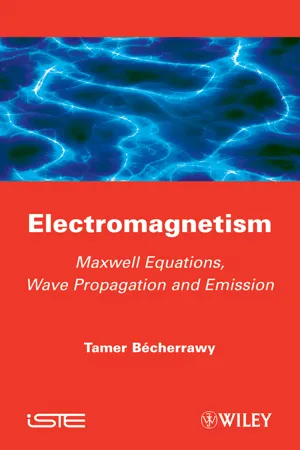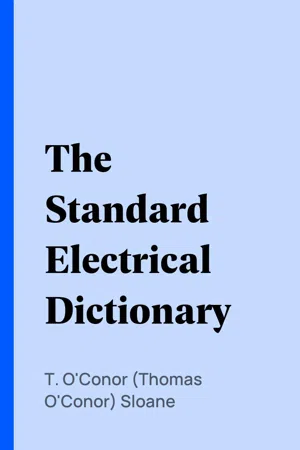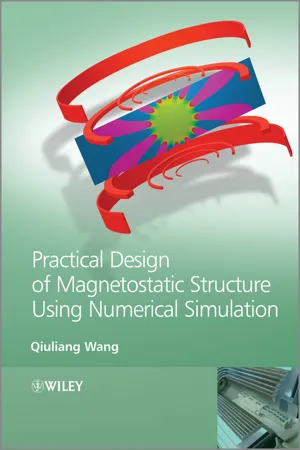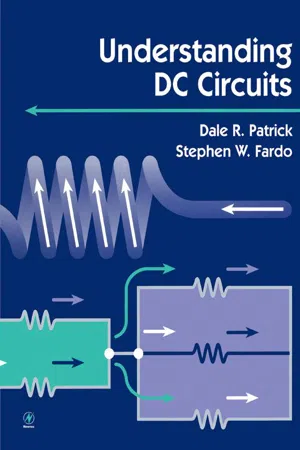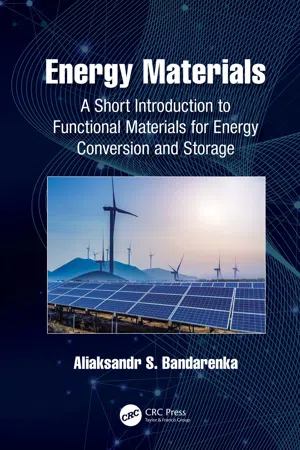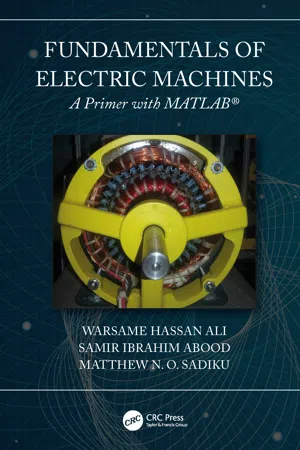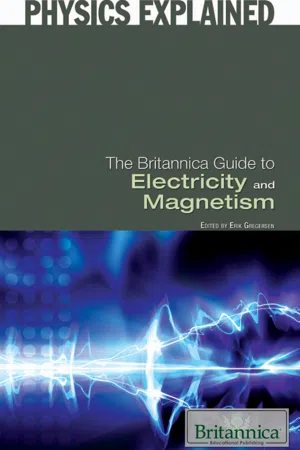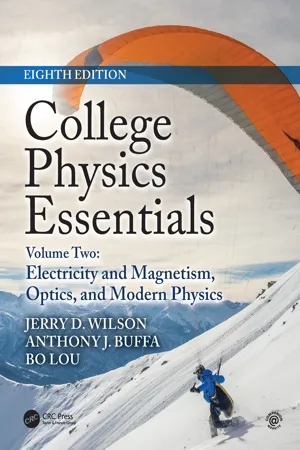Physics
Permanent and Induced Magnetism
Permanent magnetism refers to the inherent magnetic properties of certain materials, such as iron or steel, that can retain their magnetization without an external magnetic field. Induced magnetism, on the other hand, occurs when a material becomes magnetized in the presence of an external magnetic field but loses its magnetization when the field is removed.
Written by Perlego with AI-assistance
Related key terms
Related key terms
1 of 4
Related key terms
1 of 3
9 Key excerpts on "Permanent and Induced Magnetism"
- eBook - ePub
Electromagnetism
Maxwell Equations, Wave Propagation and Emission
- Tamer Becherrawy(Author)
- 2013(Publication Date)
- Wiley-ISTE(Publisher)
Chapter 7Magnetism in Matter
Before the discovery of the magnetic effects of electric current and charges, the understanding of magnetism pertained to permanent magnets. Even today, some of the magnetic properties of matter remain little understood and other properties remain to be explored. This does not prevent magnetism from underlying many applications, ranging from the magnetic compass to measurement instruments, electric generators and motors, magnetic tapes for sound and video recording and for computer data storage, magnetic levitation, etc. The purpose of this chapter is to introduce some basic elements of magnetism in matter.7.1. Types of magnetism
Some materials, said to be ferromagnetic , become magnetized if they are exposed to a magnetic field and they remain permanently magnetized if the magnetic field is removed. A magnetized body is equivalent to a magnetic moment M in a characteristic direction SN . An external magnetic field acts on this body and orients it in such a way that the field B enters the body at S and leaves it at N (Figure 7.1a ). Particularly, in the Earth's magnetic field, N points approximately toward the geographic North and S toward the South (Figure 7.1b ). However, contrary to the electric charges, which constitute an electric dipole, the “magnetic poles” cannot be separated and the concept of magnetic pole is simply an analogy with electric charges. Similar to dielectrics, which polarize if they are placed in an electric field, all materials become magnetized to some extent if they are submitted to the magnetic field B of an electric current or another magnetized body. Some materials (such as aluminum, chrome, platinum, etc.) acquire a magnetic moment in the direction of B , they are said to be paramagnetic . Other materials (such as silver, gold, copper, mercury, lead, etc.) acquire a magnetic moment in the opposite direction to B , they are said to be diamagnetic . A magnetized body produces its own magnetic field, which leaves the body near N and enters the body near S (Figure 7.1c ). - eBook - ePub
The Standard Electrical Dictionary
A Popular Dictionary of Words and Terms Used in the Practice; of Electrical Engineering
- T. O'Conor (Thomas O'Conor) Sloane(Author)
- 2008(Publication Date)
- Perlego(Publisher)
If a rod of steel is held parallel to the inclination and in the magnetic meridian it exhibits polarity, which by jarring or hammering, can be made to some extent permanent. A piece of soft iron held vertically, or still better in the line of the dip as above, and which is twisted when in that position, becomes magnetized with some degree of permanence. Many other instances are cited, such as fire-irons, lamp-posts, iron gates, lathe turnings, all of which often exhibit polarity, having been magnetized by the earth's field. [Transcriber's note: The earth's magnetic field is believed to originate it electric currents in the moving molten core.] Magnetization, Coefficient of Induced. The coefficient (q. v.) expressing the relation between the specific intensity of magnetization of a particle and the magnetizing force. The magnetizing force is measured by the lines of force it can produce in a field of air. The coefficient of induced magnetization is the factor by which the intensity of a magnetizing field must be multiplied to produce the magnetization imparted by it to a particle of any substance. This coefficient varies for different substances, and is also called magnetic susceptibility. It is distinguished from permeability as referring only to a particle isolated from influence of a mass of surrounding particles of its own kind. It is definable as the intensity of the magnetization assumed by an exceedingly long and exceedingly thin bar placed in a unit field - Qiuliang Wang(Author)
- 2013(Publication Date)
- Wiley(Publisher)
8 Permanent Magnets and their ApplicationsThe rare earth permanent magnetic materials are used to generate magnetic fields for practical research and engineering applications. They can produce magnetic fields that are the same as those of the electromagnets. There are N and S poles with opposite polarity, and the same strength in the two ends of the magnet. The characteristics of a permanent magnet material are the intrinsic quasi-square hysteresis curve, high coercivity, and anisotropy. The permanent magnets can be composed of continuous or discontinuous magnetic blocks. The magnetic field can be up to 2 T, and in a smaller range of materials, it can reach up to 5 T [1–5]. Permanent magnets can provide a magnetic field that is varied in space with special structures. The combination of permanent and ferromagnetic materials is called a magnetic circuit. It can form a closed loop of magnetic flux.The motivation for using permanent magnets is because they have the advantages of different scaling behavior, no power consumption, and being failed safe (no power supplies) compared with electromagnets. This chapter mainly discusses the design of permanent magnets and their practical engineering applications.8.1 Introduction to Magnetic Materials
8.1.1 Basic Parameters of Magnetism
The magnetic circuit equation is similar to the DC electric circuit equation. A magnetic circuit can be handled in an analogous way to an electrical circuit. The magnetic flux mentioned here is the total number of magnetic field lines through a cross-section perpendicular to the direction of the magnetic field. The basic laws of magnetic circuits are deduced from the theory of the magnetic field. The magnetic field intensity vector H is used to describe the performance of the magnetic field, which has a specific strength and direction at each point of the magnetic circuit. The field distribution can be represented by flux lines, which form a directional cluster, where the tangential direction at a point of the curve is the direction of the magnetic field. Any materials can be magnetized in the magnetic field and therefore show magnetization, M- eBook - ePub
- Dale Patrick, Stephen Fardo(Authors)
- 1999(Publication Date)
- Newnes(Publisher)
Bars or other shapes of materials that retain their magnetic properties.Permeability (μ) The ability of a material to conduct magnetic lines of force as compared with air; the ability of a material to magnetize or demagnetize.PolaritiesSee magnetic poles .Relay An electromagnetic switch that uses a low current to control a higher-current circuit.Reluctance (ℜ) The opposition of a material to the flow of magnetic flux.Residual magnetism The magnetism that remains around a material after the magnetizing force has been removed.Retentivity The ability of a material to retain magnetism after a magnetizing force has been removed.Solenoid An electromagnetic coil with a metal core that moves when current passes through the coil.Permanent Magnets
Magnets are made of iron, cobalt, or nickel, usually in an alloy combination. An alloy is a mixture of these materials. Each end of the magnet is called a pole . If a magnet were broken, each part would become a magnet. Each magnet would have two poles. Magnetic poles are always in pairs. When a magnet is suspended in air so that it can turn freely, one pole will point to the North Pole. The earth is like a large permanent magnet. This is why compasses can be used to determine direction. The north pole of a magnet attracts the south pole of another magnet. A north pole repels another north pole and a south pole repels another south pole. The two laws of magnetism are (1) like poles repel and (2) unlike poles attract.The magnetic field patterns that exist when two permanent magnets are placed end to end are shown in Fig. 4-1 . When the magnets are farther apart, a smaller force of attraction or repulsion exists. This type of permanent magnet is called a bar magnetFigure 4-1 Magnetic field patterns that exist when magnets are placed end to end,Some materials retain magnetism longer than others do. Hard steel holds its magnetism much longer than soft steel does. A magnetic field is set up around any magnetic material. The field is made up of lines of force , or magnetic flux . These magnetic flux lines are invisible. They never cross one another, but they always form individual closed loops around a magnetic material. They have a definite direction from north to south pole along the outside of a magnet. When magnetic flux lines are close together, the magnetic field is strong. When magnetic flux lines are farther apart, the field is weaker. The magnetic field is strongest near the poles. Lines of force pass through all materials. It is easy for lines of force to pass through iron and steel. Magnetic flux passes through a piece of iron as shown in Fig. 4-2 - eBook - ePub
Energy Materials
A Short Introduction to Functional Materials for Energy Conversion and Storage
- Aliaksandr S. Bandarenka(Author)
- 2022(Publication Date)
- CRC Press(Publisher)
Magnetic materials are categorized as magnetically “soft” and “hard”. Soft magnetic materials are those that can be magnetized but rarely stay magnetized for a noticeable time. A typical example, in this case, is metallic iron. Magnetically hard materials, in contrast, can remain magnetized for a long time. PMs, which are necessary for electrical motors and generators, are made from magnetically hard materials. Therefore, in the following, mainly hard magnetic materials will be considered.In order to understand the central figure of merit for the PMs important in designing the abovementioned motors and generators, one needs to introduce magnetic induction defined below.Definition:
Magnetic induction, B, is the response of a material to a magnetic field, H:B = H + 4 π MAll three parameters introduced here, namely magnetization, M, magnetic induction, B, and magnetic field, H, are used to determine how magnetically strong and hard a given material is. Let us consider the diagram shown in Figure 11.5a . It schematically illustrates an ideal dependence of magnetization on the applied magnetic field H for a hard magnet. The interpretation of this diagram is as follows. First, this diagram can provide the maximal saturation magnetization value, Ms . Then, it is clear that the application of the external magnetic field does not immediately change the Ms value. The applied H should reach a certain value, Hc , as the material tends to resist this influence. Therefore, namely the value Hc is the measure of particular magnetic material to resist demagnetization. It is called intrinsic coercivity. Hard magnetic materials have high values of Hc . Consequently, soft ones have a low resistance to demagnetization.If one uses magnetic induction B instead of M, the plot shown in Figure 11.5b can be obtained. This plot is convenient because it can help to determine a key point, |BH|max , as indicated in the figure. So, one of the central figures of merit for a PM is its so-called energy product, |BH|max . This quantity is twice the energy stored in the stray field created by the magnet. In simple terms, it can equivalently be understood as energy density (SI units define it in Joules per cubic meter). Another critical property of a PM is, as discussed above, the resistance to demagnetization, Hc . Of course, it is also essential to take into account that the magnetic state of a material largely depends on its temperature and other key variables such as pressure and the applied external magnetic field. It is also noteworthy that a bulk magnet in the permanently magnetized state is metastable; the ground state would be a state that generates no stray field. However, namely |BH|max and Hc - eBook - ePub
Fundamentals of Electric Machines: A Primer with MATLAB
A Primer with MATLAB
- Warsame Hassan Ali, Matthew N. O. Sadiku, Samir Abood(Authors)
- 2019(Publication Date)
- CRC Press(Publisher)
This magnetism is called residual, which is essential in the work of electric machines. Another criterion for measuring the susceptibility of a material to the formation of a permanent or temporary magnet is the ease with which these materials allow the lines of magnetic forces to be distributed within it. This is called the permeability of the material, so the permanent magnets have high impedance and low permeability while the temporary magnets low impedance and high permeability. The advantages of permanent magnets are: There is no operating cost, no maintenance, and high efficiency also doesn’t need electrical power to operate, which excludes the possibility of failure of the feeding system, and they can be used in a hazardous environment, do not require electrical connections, and are not affected by shocks and vibrations. The disadvantage of permanent magnets is difficulty controlling their power. While the advantages of temporary magnets are ease of control over their ability, loadable, and withstand higher temperatures than permanent magnets, and can cut the feed and the field distance and edit the load easily. The disadvantages of temporary magnets, it needs a power source and exposure to the problems of potential disruption of this source, and that it can operate in a specific environment because it does not resist water, heat, and shocks. 1.4 Applications of Magnet Magnets are widely used in power generation, transmission, and transmission systems. They are the basis for the work of the electrical stations that convert mechanical energy (in the form of heat to generate steam or waterfalls) to electrical power. In addition, it is the basis for the work of electrical transformers that convert the voltage from the amount supplied to other quantities needed by electrical and electronic devices - Britannica Educational Publishing, Erik Gregersen(Authors)
- 2010(Publication Date)
- Britannica Educational Publishing(Publisher)
4 ), belongs to a class of substances known as ferrites. Ferrites and some other classes of magnetic substances discovered more recently possess many of the properties of ferromagnetic materials, including spontaneous magnetization and remanence. Unlike the ferromagnetic metals, they have low electric conductivity, however. In alternating magnetic fields, this greatly reduces the energy loss resulting from eddy currents. Since these losses rise with the frequency of the alternating field, such substances are of much importance in the electronics industry.A notable property of ferrites and associated materials is that the bulk spontaneous magnetization, even at complete magnetic saturation, does not correspond to the value expected if all the atomic dipoles are aligned parallel to each other. The explanation was put forward in 1948 by Néel, who suggested that the exchange forces responsible for the spontaneous magnetization were basically antiferromagnetic in nature and that in the ordered state they contained two (or more) sublattices spontaneously magnetized in opposite directions. In contrast to the simple antiferromagnetic substances considered above, however, the sizes of the magnetization on the two sublattices are unequal, giving a resultant net magnetization parallel to that of the sublattice with the larger moment. For this phenomenon Néel coined the name ferrimagnetism, and substances that exhibit it are called ferrimagnetic materials.MAGNETS
A magnet is any material capable of attracting iron and producing a magnetic field outside itself. By the end of the 19th century all the known elements and many compounds had been tested for magnetism, and all were found to have some magnetic property. The most common was the property of diamagnetism, the name given to materials exhibiting a weak repulsion by both poles of a magnet. Some materials, such as chromium, showed paramagnetism, being capable of weak induced magnetization when brought near a magnet. This magnetization disappears when the magnet is removed. Only three elements, iron, nickel, and cobalt, showed the property of ferromagnetism (i.e., the capability of remaining permanently magnetized).MAGNETIZATION PROCESSThe quantities now used in characterizing magnetization were defined and named by William Thomson (Lord Kelvin) in 1850. The symbol B denotes the magnitude of magnetic flux density inside a magnetized body, and the symbol H denotes the magnitude of magnetizing force, or magnetic field, producing it. The two are represented by the equation B = μH , in which μ symbolizes the permeability of the material and is a measure of the intensity of magnetization that can be produced in it by a given magnetic field. The modern units of the SI system for B are teslas (T) or webers per square metre (Wb/m2 ) and for H- eBook - ePub
Magnet Therapy
The Gentle and Effective Way to Balance Body Systems
- Ghanshyam Singh Birla, Colette Hemlin(Authors)
- 1999(Publication Date)
- Healing Arts Press(Publisher)
Chapter ThreePROPERTIES OF MAGNETSNow that we have looked at the origins and composition of magnets, we will explore their physical properties—characteristics that apply to all magnets, regardless of their origin, size, composition, or strength. However, it is necessary to explain some basic terms of magnetism before we examine those properties in detail.Magnetic field: A magnet (or an electric wire with current passing through it) is surrounded by a field that attracts objects. This is called the magnetic field.Magnetic induction: The basic vectorial dimension used to describe the magnetic field is known as magnetic induction and is described in terms of length and direction. Graphically, magnetic induction is represented by induction lines (just as force lines represent an electric field).Induction lines: These are drawn so that the number of lines per the surface area perpendicular to them is proportional to the intensity of the field. This means that tightly grouped lines represent a strong field, whereas more sparsely placed lines represent a weak field.Magnetic strength: The number of lines per given surface area determines the strength of a magnet. For instance, a 1,000-gauss magnet is stronger than a 500gauss magnet and can attract more iron. (Please note that in physics, the terms “strength” and “power” are not synonymous. However, for our purposes it is not necessary to explain the sometimes complex difference between these two concepts.)Flux: The flow of magnetic energy that circulates is known as the flux of the magnet.PHYSICAL PROPERTIES OF MAGNETSYou have no doubt observed that the attraction-and-repulsion phenomenon can take place at a certain distance from a magnet. As indicated above, the zone in which a magnet produces its effect is called the magnetic field. We will discuss this field later in more detail. However, for now, we will examine the main magnetic effects existing in this field. - eBook - ePub
College Physics Essentials, Eighth Edition
Electricity and Magnetism, Optics, Modern Physics (Volume Two)
- Jerry D. Wilson, Anthony J. Buffa, Bo Lou(Authors)
- 2019(Publication Date)
- CRC Press(Publisher)
Figure 19.24b ). Remembering the picture of the electron spin acting as a small compass, they begin to “line up” in the external field. As the external field and the iron bar interact, the iron exhibits the following two effects:1.Domain boundaries change as some of the domains with magnetic orientations in the direction of the external field grow at the expense of the others. 2.The magnetic orientation of some domains may change slightly so as to be more aligned with the field. Upon removal of the external field, the iron domains will remain more or less aligned in the original external field direction, thus creating an overall “permanent” magnetic field of their own.▲ Figure 19.24 Magnetic domains (a) With no external magnetic field, the magnetic domains of a ferromagnetic material are randomly oriented and the material is unmagnetized. (b) In an external magnetic field, domains with orientations parallel to the field may grow at the expense of other domains, and the orientations of some domains may become more aligned with the field. (c) As a result, the material becomes magnetized.Now you can also understand why an unmagnetized piece of iron is attracted to a magnet and why iron filings line up with a magnetic field. Essentially, the pieces of iron become induced magnets (Figure 19.24c ).19.7.1 Electromagnets and Magnetic PermeabilityFerromagnetic materials are used to make electromagnets, usually by wrapping a wire around an iron core (▶ Figure 19.25a ). When the current is on, it induces magnetism in ferromagnetic materials (for example, the iron sliver in Figure 19.25b ) and, if the forces are large enough, it can be used to pick up large amounts of scrap iron (Figure 19.25c ). When an electromagnet is on (lower drawing in Figure. 19.25a
Index pages curate the most relevant extracts from our library of academic textbooks. They’ve been created using an in-house natural language model (NLM), each adding context and meaning to key research topics.
Explore more topic indexes
Explore more topic indexes
1 of 6
Explore more topic indexes
1 of 4
